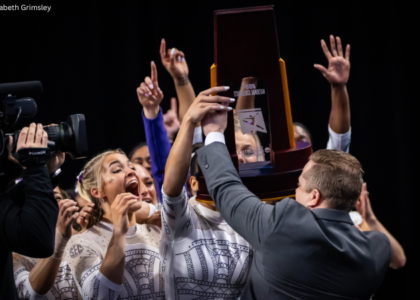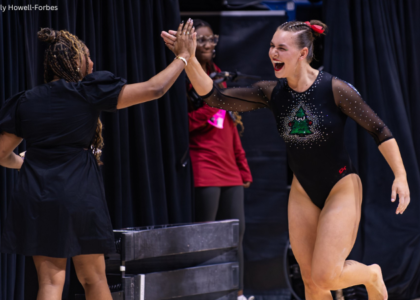New season, new rules. Earlier this month, the NCAA released its updated Rules Modification Document with all the changes it has adopted for the upcoming college gymnastics season, and earlier this summer, it updated its annual report with some noticeable changes to championships. We break down all the notable modifications and how they will affect the 2024 season.
Failure to Hold Finishing Position
In the latest attempt to eliminate the infamous college stick, gymnasts must hold their finishing position on vault, uneven bars, and balance beam for at least one second or incur a half-tenth deduction. Whether the gymnast sticks the landing or takes a step or two, we will see an increased effort from gymnasts to pause before saluting, making this the most visible change fans will notice this season.
Interpretation from former judge Rhiannon Franck:
Although I haven’t seen any official clarification, if an athlete does a “college stick” and doesn’t hold the finishing position and takes a small adjustment, the judges will likely still only deduct half a tenth. It’s unlikely that athletes will be deducted for both adjustments and failing to hold finishing position.
Vault Landing Line Positioning
Teams will now be hit with deductions for not properly placing or showing the vault landing lines introduced last season. A two-tenth team deduction will be given if the lines are not taped or screened onto the mat correctly or not chalked onto an additional top mat correctly. And like last year, there are still no actual deductions for landing on or stepping over the lines, they are just acting as a visual aid for judges.
Skill Values
While no major skill values changed, the committee clarified how it will evaluate skills. After the NCAA adopts this season’s USA Gymnastics level 10 code of points on Nov. 1, 2023, it will honor any skill values USAG raises on events other than vault after that date. However, if USAG devalues a skill, the skill value will not be lowered in the NCAA’s version of the code until the following year. It was also clarified that skills not found in the USAG code must be submitted in writing to the Regional Technical Committee for evaluation.
Tri-Meet Format
While not a new modification this season, we may see a few tri-meets with an amended structure due to the current judge shortage. The modified tri-meet is a six-rotation meet with byes to accommodate using just two judging panels instead of four. Typical of a dual meet, vault and bars would be conducted in the first half of the meet, with beam and floor in the second half. Below is the table included in the modification document.
| Vault | Bars | Bye | Beam | Floor | Bye |
| Home Team | Visitor 1 | Visitor 2 | Home Team | Visitor 2 | Visitor 1 |
| Visitor 2 | Home Team | Visitor 1 | Visitor 2 | Visitor 1 | Home Team |
| Visitor 1 | Visitor 2 | Home Team | Visitor 1 | Home Team | Visitor 2 |
With most programs and event organizers trending toward meets without byes over the last few seasons, we may see fewer tri-meets to avoid this awkward structure.
Championship Format
An important update from the NCAA Women’s Gymnastics Committee earlier this summer is worth noting, as we will see some changes to next year’s NCAA championships. After a request from ESPN to increase broadcast viewership, changes are being made to the timing of the meet.
The most notable change is the introduction of staggered events during competition so that no more than two routines occur simultaneously. At the beginning of each rotation, the leadoffs on vault and bars will be given the green flag to start their routines while beam and floor athletes wait. Approximately 20 seconds after the opening vault has been completed, the beam judges will give the green flag to the beam leadoff to compete, and 20 seconds after her routine-ending salute, the vault judges will give the next vaulter the go-ahead. Similarly, the leadoff floor performer will begin 20 seconds after the opening bars routine ends, with a 20-second pause after floor before the next bars routine starts. These patterns will repeat until the end of the rotation.
Per a memo from the NCAA, the changes were made to improve the audience experience, stating, “It proved to be difficult to follow simultaneous competition on four events in-venue and on the broadcast from a viewing and scoring perspective.” These changes aren’t expected to have a major impact on the length of the meet, with the memo also noting this will allow for broadcasters to fit the event more appropriately in a two-hour time window.
READ THIS NEXT: Judge’s Inquiry: Determining the Real Winner From Past Ties
Article by Brandis Heffner and Rhiannon Franck





3 comments